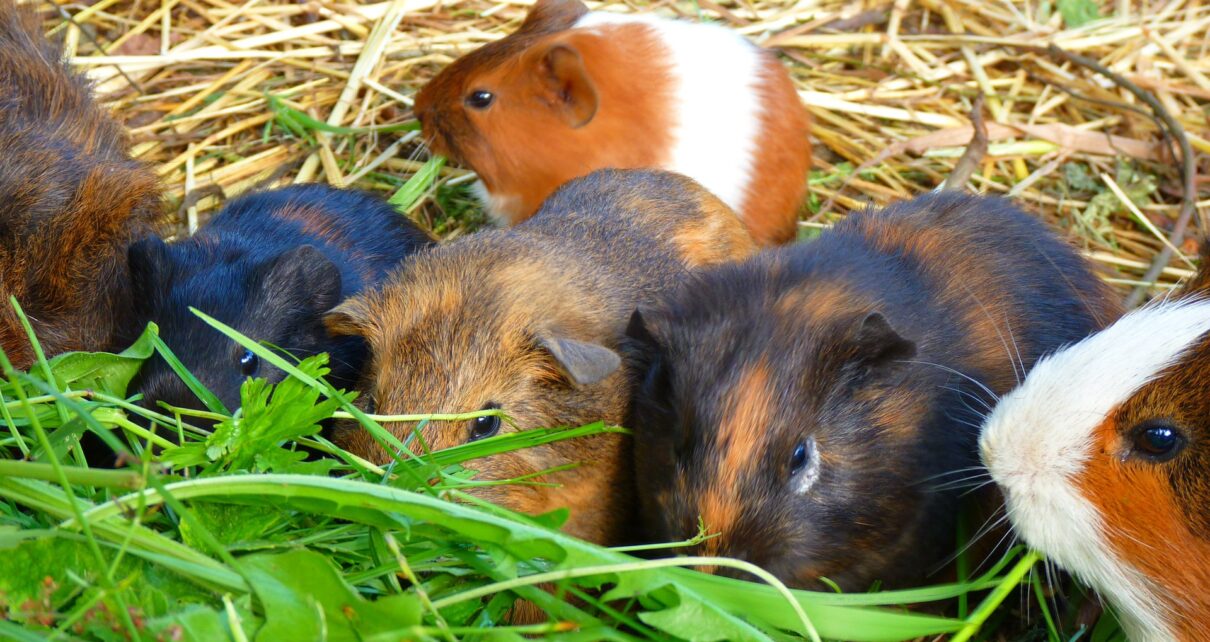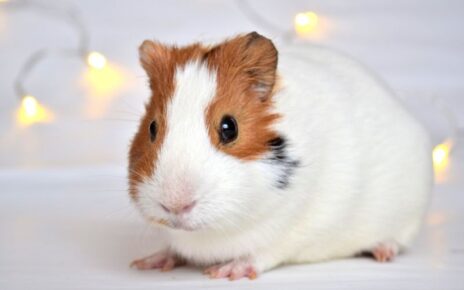The following list of low calcium vegetables for guinea pigs will help you choose the healthiest and best veggies for guinea pigs.
If a guinea pig eats vegetables with too much calcium it can lead to the formation of bladder or kidney stones, which can be extremely painful for a guinea pig, and if they get too large they might even require medical attention.
That’s why it’s best to feed your guinea pig low calcium vegetables to minimize the risk of any future health problems.
How Much Calcium Should a Guinea Pig Have A Day
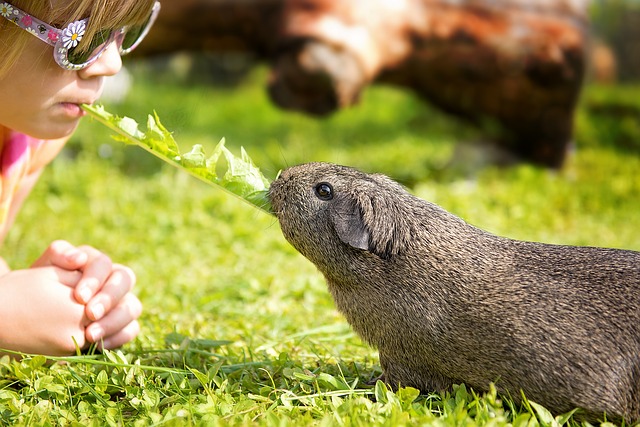
A guinea pig will need to eat 3.6 to 4.5 grams of calcium for each pound of body weight. They also need 1.8 to 3.2 grams of phosphorus, 0.45 to 1.4 grams of magnesium, and 2.3 to 6.4 grams of potassium for each pound of body weight.
Adult Male Guinea Pig Calcium per Day
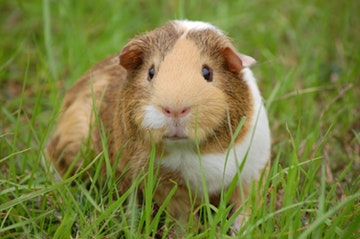
Weight: 2 to 2.65 Pounds (900g – 1200g)
Calcium: 7.2 to 9.6-grams
Adult Female Guinea Pig Calcium per Day
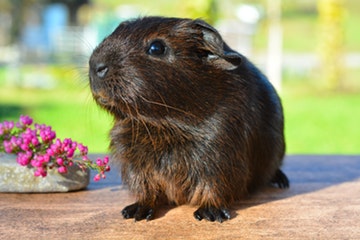
Weight: 1.5 to 2 Pounds (700 – 900g)
Calcium: 5.6 to 7.2-grams
Calcium Absorption

How much calcium a guinea pig will absorb from their food also has to do with the amount of calcium relative to phosphorus. That means a guinea pig will actually retain more calcium when they have enough phosphorus in their diet.
Calcium that isn’t absorbed will eventually end up passing through your guinea pig’s kidneys and bladder. This means even if you feed your guinea pig low calcium vegetables they can still develop bladder stones if they don’t get the right amount of phosphorus.
In the following section, we’ll go over the ideal guinea pig calcium-phosphorus ratio in more detail, so you can choose the best veggies for your guinea pig by also taking into consideration their phosphorus content.
Guinea Pig Calcium:Phosphorus Ratio
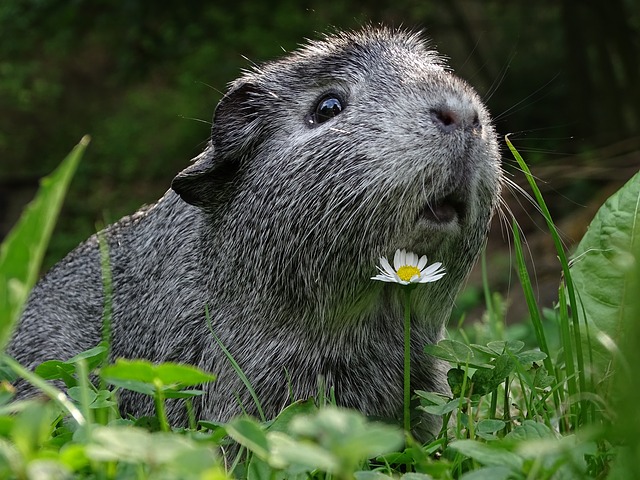
The ideal guinea pig calcium to phosphorus ratio is 1.33 to 1. That means a guinea pig should consume 1.33 times more calcium in their diet relative to phosphorus.
For example, studies [1] have found that guinea pigs retain more calcium when they are fed a diet with a 1.2 to 1 calcium to phosphorus ratio, compared to a 2 to 1 Ca:P ratio.
You can calculate the amount of calcium and phosphorus your guinea pig eats by weighing all their food and adding up the total calcium and phosphorus content.
Alternatively, you can try to feed your guinea pig foods that have an optimal calcium to phosphorus ratio if you want to ensure your guinea pig is always eating a balanced diet.
Low Calcium Vegetables for Guinea Pigs
Beets
Beets (Buy Online) are a nutrient-rich root vegetable that contains a good amount of antioxidants. A 100 gram serving of Beets contains 16mg of calcium, 40mg of phosphorus, and 23mg of magnesium. In addition, beets have a 0.4:1 Ca:P ratio, which means beets contain more phosphorus than calcium. In addition, Beets only contain a limited amount of Vitamin C at 4.9mg in each 100-gram serving. However, beets make good roughage since they have a 2.8% dietary fiber content.
Cucumber
Cucumber (Buy Online) is a refreshing low calcium vegetable. A 100 gram serving of cucumber contains 16mg of calcium, 24mg of phosphorus, and 13mg of magnesium. Giving cucumbers a Ca:P ratio of 0.66:1, which means they contain a little too much phosphorus in relation to calcium. Cucumbers do contain minimal amounts of Vitamin C at 2.8mg in a 100-gram serving. Also, cucumbers only have a 0.5% dietary fiber content.
Belgian Endive – Witloof Chicory
Belgian Endive (Buy Online) produces a small head that’s grown in the dark to keep the leaves tender. A 100 gram serving of Belgian Endive contains 19mg of calcium, 26mg of phosphorus, and 10mg of magnesium, and Belgian Endive has a Ca:P ratio of 0.73:1. In addition, Belgian Endive only contains a limited amount of Vitamin C at 2.8mg in each 100-gram serving. However, Belgian Endive is an excellent source of roughage with its 3.1% dietary fiber content.
Asparagus
Asparagus (Buy Online) is a perennial plant that produces nutritious young shoots every spring. A 100 gram serving of asparagus contains 24mg of calcium, 52mg of phosphorus, and 14mg of magnesium, and asparagus has a Ca:P ratio of 0.46:1. Asparagus only contains minimal amounts of Vitamin C at 5.6mg per 100-gram serving. Also, asparagus does have a decent 2.1% dietary fiber content.
Cauliflower
Cauliflower (Buy Online) produces tender flower buds in a wide range of colors along with edible leaves and stems. A 100 gram serving of cauliflower contains 22mg of calcium, 44mg of phosphorus, and 15mg of magnesium and cauliflower has a Ca:P ratio of 0.41:1. In addition, cauliflower is an excellent source of Vitamin C at 46.4mg per 100-gram serving. Cauliflower is also a good source of roughage for a guinea pig since it has a 2.5% dietary fiber content.
Kohlrabi
Kohlrabi (Buy Online) is a relative of broccoli and cauliflower and it’s grown for its thick tender stem instead of its flowers. A 100 gram serving of kohlrabi contains 24mg of calcium, 46mg of phosphorus, and 19mg of magnesium, and kohlrabi has a Ca:P ratio of 0.52:1. Kohlrabi is an excellent source of Vitamin C at 62mg in each 100-gram serving, and it has a very high 3.1% dietary fiber content.
Turnip
Turnips (Buy Online) are a great root crop for guinea pigs since they have a nearly ideal calcium to phosphorus ratio. A 100 gram serving of turnips contains 30mg of calcium, 27mg of phosphorus, and 11mg of magnesium, and turnips have a Ca:P ratio of 1.11:1. Turnips are also a very good source of Vitamin C at 21mg per 100-gram serving. However, turnips only have a 1.8% dietary fiber content.
Squash – Winter
Winter Squash (Buy Online) is a vitamin-rich fruit/vegetable that’s a close relative of gourds and pumpkins. A 100 gram serving of winter squash contains 32mg of calcium, 26mg of phosphorus, and 16mg of magnesium, and winter squash has a Ca:P ratio of 1.23:1, which gives winter squash a nearly perfect calcium to phosphorus ratio. Winter squash is also a good source of Vitamin C at 14mg per 100-gram serving. But, winter squash isn’t a good source of fiber since it only has a 1.7% dietary fiber content.
Carrots, Baby
Baby Carrots (Buy Online) aren’t just for rabbits since guinea pigs also love to eat them. A 100 gram serving of baby carrots contains 32mg of calcium, 28mg of phosphorus, and 10mg of magnesium. That means baby carrots have an almost ideal Ca:P ratio of 1.15:1. Baby carrots only contain a small amount of Vitamin C at 2.6mg per 100-gram serving. However, baby carrots are a good source of roughage with their 2.9% dietary fiber content.
Alfalfa Sprouts
Alfalfa Sprouts (Buy Online) are quick and easy to grow, and they are a great way to add fresh vegetables to a guinea pigs diet. A 100 gram serving of alfalfa sprouts contains 32mg of calcium, 70mg of phosphorus, and 27mg of magnesium, and alfalfa sprouts have a Ca:P ratio of 0.45:1. Alfalfa sprouts don’t contain much Vitamin C with only 8.2mg of this vital nutrient in each 100-gram serving, and they also only have a 1.9% dietary fiber content.
Lettuce, Butterhead
Butterhead Lettuce (Buy Online) is a very nutritious leafy green to add to a guinea pigs diet. A 100 gram serving of butterhead lettuce contains 36mg of calcium, 33mg of phosphorus, and 13mg of magnesium, which gives butterhead lettuce a nearly ideal Ca:P ratio of 1.09:1. However, butterhead lettuce only contains a small amount of Vitamin C at 3.7mg in each 100-gram serving. Butterhead lettuce also won’t serve as a good source of roughage since it only has a 1.1% dietary fiber content.
Parsnips
Parsnips (Buy Online) are a nutritious root crop that are part of the Apiaceae family along with parsley and carrots. A 100 gram serving of Parsnips contains 36mg of calcium, 71mg of phosphorus, and 29mg of magnesium. That means Parsnips have a Ca:P ratio of 0.5:1 due to the fact that they contain a lot more phosphorus relative to calcium. In addition, Parsnips contain 17mg of Vitamin C in each 100-gram serving. and they are an excellent source of roughage since they have a 4.9% dietary fiber content.
Green Beans
Green Beans (Buy Online) are a great crunchy treat that you can feed to your guinea pig in moderation. A 100 gram serving of Green Beans contains 37mg of calcium, 38mg of phosphorus, and 25mg of magnesium. Which gives Green Beans a nearly ideal Ca:P ratio of 0.97:1. Green Beans are also a good source of Vitamin C with 16.3mg in each 100-gram serving, and they are an excellent source of roughage since they have a 3.4% dietary fiber content.
Sweet Potato Leaves
Sweet Potato Leaves (Buy Online) are a nice treat for a guinea pig that you can easily grow in your garden. A 100 gram serving of Sweet Potato Leaves contains 37mg of calcium, 94mg of phosphorus, and 31mg of magnesium. That means Sweet Potato Leaves have a pretty unbalanced Ca:P ratio of 0.39:1. In addition, Sweet Potato Leaves contain a limited amount of Vitamin C at 11mg in each 100-gram serving. However, they are a good source of roughage since they have a 2% dietary fiber content.
Celery
Celery (Buy Online) is a crisp vegetable that has a very high moisture content. Each 100 gram serving of Celery contains 40mg of calcium, 24mg of phosphorus, and 11mg of magnesium. That puts the Ca:P ratio of Celery at 1.66:1, which means celery has a good calcium to phosphorus ratio. However, celery doesn’t contain much vitamin C since it only contains 3.1mg of Vitamin C in each 100-gram serving.
Cabbage
Cabbage (Buy Online) is a leafy green vegetable that can be more nutritious for a guinea pig than lettuce. A 100 gram serving of Cabbage contains 40mg of calcium, 26mg of phosphorus, and 12mg of magnesium. That means Cabbage has a Ca:P ratio of 1.54:1. In addition, cabbage is a good source of Vitamin C at 21mg per 100-gram serving, and it also contains 2.5% dietary fiber.
Broccoli
Broccoli (Buy Online) is a nutrient-rich vegetable that has a relatively low calcium content, but it does contain a lot of phosphorus. Each 100 gram serving of Broccoli contains 47mg of calcium, 66mg of phosphorus, and 21mg of magnesium. That gives Broccoli a Ca:P ratio of 0.7:1, which means it doesn’t have an ideal calcium to phosphorus ratio. However, broccoli does contain a good amount of Vitamin C at 89.2mg in each 100-gram serving, and it’s a good source of roughage with a 2.6% dietary fiber content.
Swiss Chard
Swiss Chard (Buy Online) is a colorful tasty treat that makes a great addition to a guinea pigs diet. Each 100 gram serving of Swiss Chard contains 51mg of calcium, 46mg of phosphorus, and 81mg of magnesium. That gives Swiss Chard a Ca:P ratio of 1.11:1, which means Swiss Chard has a nearly ideal calcium to phosphorus ratio. Swiss Chard also contains 30mg of vitamin C in each 100-gram serving, and it has a 1.6% dietary fiber content.
Purslane
Purslane (Buy Online) is a hardy succulent plant that’s rich in vitamins and minerals. A 100 gram serving of Purslane contains 65mg of calcium, 44mg of phosphorus, and 68mg of magnesium. That means Purslane has a Ca:P ratio of 1.47:1. Purslane is also a good source of Vitamin C at 21mg of vitamin C per 100 gram serving
Cilantro
Cilantro (Buy Online) is a tasty herb that you can feed to your guinea pig in moderation. Each 100 gram serving of Cilantro contains 67mg of calcium, 48mg of phosphorus, and 26mg of magnesium. That gives Cilantro a good Ca:P ratio of 1.4:1. Cilantro also contains 27mg of vitamin C in each 100-gram serving, and it also is a good source of roughage since cilantro has a 2.8% dietary fiber content.
Low Calcium Vegetables for Guinea Pigs Chart
CALCIUM per 100 grams — Vegetables | |
Corn, White | 2 mg |
Tomato | 5 mg |
Peppers,Red | 9 mg |
Peppers,Green | 9 mg |
Cucumber (with skin) | 14 mg |
Beets | 16 mg |
Endive, Belgian (Witloof Chicory) | 19 mg |
Squash (summer, all varieties) | 20 mg |
Asparagus | 21 mg |
Pumpkin | 21 mg |
Sweet Potato | 22 mg |
Cauliflower | 22 mg |
Carrots, Baby | 23 mg |
Kohlrabi | 24 mg |
Carrots | 27 mg |
Turnip | 30 mg |
Winter Squash | 31 mg |
Lettuce, Butterhead (Boston, Bibb) | 32 mg |
Alfalfa Sprouts | 32 mg |
Lettuce, Romaine | 36 mg |
Parsnips | 36 mg |
Sweet Potato Leaves | 37 mg |
Green Beans | 37 mg |
Celery | 40 mg |
Brussels Sprouts | 42 mg |
Cabbage | 47 mg |
Rutabaga | 47 mg |
Broccoli | 48 mg |
Swiss Chard | 51 mg |
Endive (Escarole) | 52 mg |
Purslane | 65 mg |
Cilantro | 67 mg |
Lettuce, LooseLeaf | 68 mg |
Okra | 81 mg |
Spinach | 99 mg |
Chicory Greens | 100 mg |
Mustard Greens | 103 mg |
Chinese Cabbage (pak-choi) | 105 mg |
Beet Greens | 119 mg |
Watercress | 120 mg |
Kale | 135 mg |
Parsley | 138 mg |
Collards | 145 mg |
Dandelion Greens | 187 mg |
Turnip Greens | 190 mg |
Dill Weed | 208 mg |
Spinach, Mustard | 210 mg |
Lambs quarters | 309 mg |

